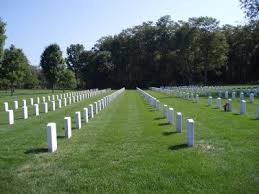Fort Custer National Cemetery
Introduction
Text-to-speech Audio
Images
A stone wall marks the entrance to the grounds of the cemetery.

Photo of a small section of the gravesites.

Backstory and Context
Text-to-speech Audio
Fort Custer was originally built in 1917 on 130 acres of land and was used as a means for military mobilization during World War I. In 1923, the fort gained another 675 acres in order to build a Veterans Hospital on the grounds. The formation of Fort Custer Post Cemetery, known today as Fort Custer National Cemetery, didn't occur until September 1943. Army rules stated that officers had to be seperate from enlisted men, therefore there were two sections to the cemetery. Section O was resevered for officers only, while Section A was for enlisted servicemen. It is also home to 26 WWII German POWs as well as a grave of an unknown soldier from the Civil War era.
Over 30,000 of our great men and women of the military are buried here and the cemetery is still expanding. There are approximately 30 memorials located throughout the cemetery grounds, each one representing some form of military organization or group. In addition to these, there is a Memorial Carillon donated by AMVETS with other smaller carillons located in each service building. The public can view these impressive sights and sounds daily. For more information on scheduling a burial or other questions, see the official website of the VA (link below).
This cemetery offers an alcove where visitors can get gravesite information as well as maps to specific locations within the cemetery grounds. Visitation is allowed daily from daylight to dark. There is what is called "The Avenue of Flags" located along the main road that consists of 152 flag poles. Flags are flown through the cemetery from Easter through Veterans Day. There are also an additional 50 flags, one for each state, that are displayed on specail occasions such as Memorial Day.
